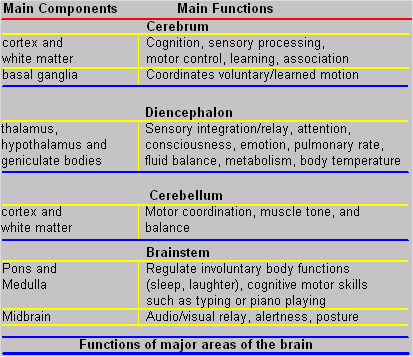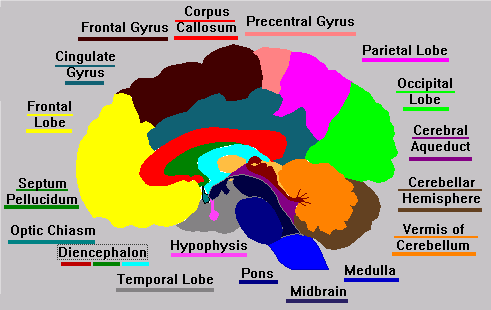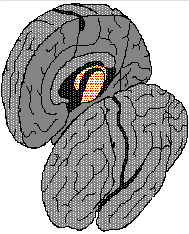05 Sep Brain Form and Function
Functional Morphology
I’ve addressed questions related to modeling form, function and process in an earlier post. Today’s post drills down in some specific areas to point out some important connections between form and function that could contribute to engineering systems that more accurately model the human brain. Paul Churchland suggests that many AI initiatives have gone too far afield from the human brain, and we need to return to a more Brain-like foundation (Baumgartner 1995).

The table describes the general functional morphology of some of the major parts of the brain. The cerebellum, diencephalon and hippocampus are described in other posts (1), (2), (3). Functions of certain areas are not yet fully understood, but the stated functions are generally considered accurate. In another post I take a more detailed look at the coordination between areas in the cerebrum, the region of the brain most commonly associated with thinking, and where contextual cues are processed.
| Understanding Context Cross-Reference |
|---|
| Click on these Links to other posts and glossary/bibliography references |
|
|
|
| Prior Post | Next Post |
| Eclecticism and Cognitive Modeling | Varied Neural Circuits in the Cerebellum |
| Definitions | References |
| form function | Baumgartner 1995 Churchland 1989 |
| cerebrum cerebellum | Gluhbegovic 1980 O'Keefe 1989 |
| neural network | Pansky 1988 LeDoux 1996 |

This is a cut-away view or median sagittal section of the human brain. Let’s look at the organization of the cerebrum to punctuate the nature and extent of specialization and cross-over in the brain. As I continue this analysis, I will narrow my focus to specific roles of neural parts. The interaction of extra-cranial components of cognition will be revisited later.
The emphasis I place on functional specialization and interaction of different parts in the brain is a response to assumptions driving some neural network implementations. It is possible that a massively parallel collection of identical simple processors without direct access to stored symbolic data is no more brain-like than one single complex processor directly connected to large amounts of memory and storage.
The cerebrum is the largest part of the brain. With nearly 14 billion neurons it is an essential part of the apparatus of cognition (including perception). As shown in previous posts, the brain’s other components are also necessary to support cognitive processes such as recognition.
Hemispherics
 The terms “right brain” and “left brain” refer to different sides of the same organ, not two different brains. The cerebrum is a paired hemi-spherical structure in which the left hemisphere controls the right side of the body. Consequently, it has been said that left-handed people are the only ones in their right mind. There are other functions (besides which-handedness) that are specific to the dominant hemisphere, such as the linguistic processes of interpreting and cataloging that occur in the occipital lobe.
The terms “right brain” and “left brain” refer to different sides of the same organ, not two different brains. The cerebrum is a paired hemi-spherical structure in which the left hemisphere controls the right side of the body. Consequently, it has been said that left-handed people are the only ones in their right mind. There are other functions (besides which-handedness) that are specific to the dominant hemisphere, such as the linguistic processes of interpreting and cataloging that occur in the occipital lobe.
Separating the hemispheres can be very traumatic because each side performs specialized roles. A type of operation called split-brain surgery disconnects the hemispheres. When this happens, the sides can no longer communicate with each other. Since language functions are generally in the left side, people whose sides are split can only talk about things the left side knows about (LeDoux, 1996). This idea has interesting implications for cognitive health.
The cerebrum dominates all other parts of the brain. It is described as a “newer” structure because it is found only in advanced vertebrates while other parts of the human nervous system resemble structures present in less advanced creatures thought to have evolved earlier (hence older). Older structures control the more physical and instinctive functions.
Do cybernetic systems such as MIPUS need to have a split brain for any reason? Do they need to have a combination of advanced and primitive structures to support the range of functions for which such systems will be designed? The questions of brain form and function will help guide our discussion going forward. We’ll visit this more in coming posts and tie questions of form and function to real automated capabilities and outcomes.
| Click below to look in each Understanding Context section |
|---|
| Intro | Context | 1 | Brains | 2 | Neurons | 3 | Neural Networks |
| 4 | Perception and Cognition | 5 | Fuzzy Logic | 6 | Language and Dialog | 7 | Cybernetic Models |
| 8 | Apps and Processes | 9 | The End of Code | Glossary | Bibliography |








